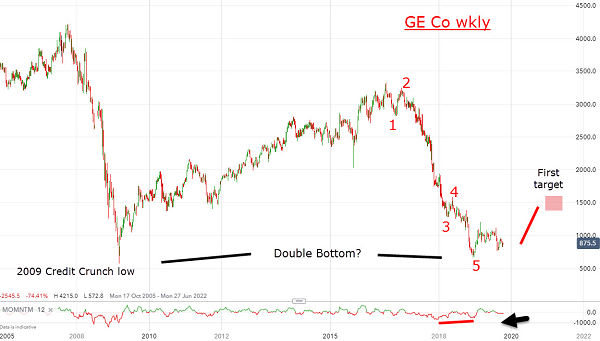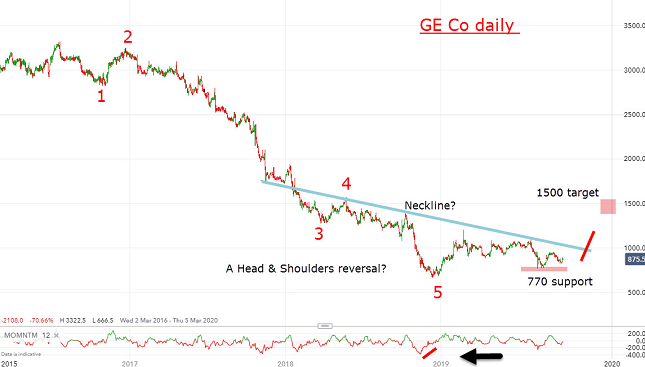Chart of the week: A Dow original begins resurgence
It's struggled for a couple of years, but this famous company's stock is looking attractive again.
21st October 2019 11:28
by John Burford from interactive investor
It's struggled for a couple of years, but this famous company's stock is looking attractive again.

Can General Electric spark renewed investor interest?
Formed in 1892, this famous US company is the last surviving original member of the Dow Jones Industrial Average, which first saw life in 1896 at the start of the Electric Age. In its day, General Electric (NYSE:GE) acted just like one of today's high-flying tech issues. But this lumbering giant has recently fallen on hard times as it has a massive problem in the pensions liability to its army of former workers.
But is all the 'bad' news now in the price? After all, the shares have collapsed from $32 two years ago to a recent low of just under $7 – a hefty loss of around 80%. So, can I add this to my Buy Low/Sell High list?
Let's take a look at the long-term weekly chart:

Source: interactive investor Past performance is not a guide to future performance
The stand-out feature is the possible Double Bottom pattern that is a reversal pattern – if genuine. Not only that, but the move off the 2016 high appears to be a complete impulsive Elliott wave to the fifth-wave low last December at the $6.70 level.
Not only that, but there is a stark momentum divergence at the third and fifth-wave lows that strongly suggests the buying power is slowly taking over.
Let's take a look at that decline on the daily chart:

Source: interactive investor Past performance is not a guide to future performance
Note the momentum divergence also on this scale to the December low – a potentially very bullish factor. And off that low, the market has risen in the longest rally phase since 2015.
But note the potential for a classic Head & Shoulders reversal with the Right Shoulder at the August low at $7.70. So, I have two potentially powerful independent reversal patterns at work. Hmm.
If the support there can hold, the market has every chance to continue advancing towards the 'neckline' around the $9.50 - $10 zone.
And breaking above that would set the H&S reversal in place and project a first target around $15. With downside limited to $7.70 and minimum upside at $15, the current $8.75 presents a very favourable reward/risk ratio.
For more information about Tramline Traders, or to take a three-week free trial, go to www.tramlinetraders.com.
John Burford is the author of the definitive text on his trading method, Tramline Trading. He is also a freelance contributor and not a direct employee of interactive investor.
These articles are provided for information purposes only. Occasionally, an opinion about whether to buy or sell a specific investment may be provided by third parties. The content is not intended to be a personal recommendation to buy or sell any financial instrument or product, or to adopt any investment strategy as it is not provided based on an assessment of your investing knowledge and experience, your financial situation or your investment objectives. The value of your investments, and the income derived from them, may go down as well as up. You may not get back all the money that you invest. The investments referred to in this article may not be suitable for all investors, and if in doubt, an investor should seek advice from a qualified investment adviser.
Full performance can be found on the company or index summary page on the interactive investor website. Simply click on the company's or index name highlighted in the article.
Disclosure
We use a combination of fundamental and technical analysis in forming our view as to the valuation and prospects of an investment. Where relevant we have set out those particular matters we think are important in the above article, but further detail can be found here.
Please note that our article on this investment should not be considered to be a regular publication.
Details of all recommendations issued by ii during the previous 12-month period can be found here.
ii adheres to a strict code of conduct. Contributors may hold shares or have other interests in companies included in these portfolios, which could create a conflict of interests. Contributors intending to write about any financial instruments in which they have an interest are required to disclose such interest to ii and in the article itself. ii will at all times consider whether such interest impairs the objectivity of the recommendation.
In addition, individuals involved in the production of investment articles are subject to a personal account dealing restriction, which prevents them from placing a transaction in the specified instrument(s) for a period before and for five working days after such publication. This is to avoid personal interests conflicting with the interests of the recipients of those investment articles.